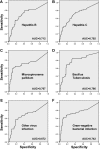Elevation of soluble major histocompatibility complex class I related chain A protein in malignant and infectious diseases in Chinese patients
- PMID: 23181907
- PMCID: PMC3552998
- DOI: 10.1186/1471-2172-13-62
Elevation of soluble major histocompatibility complex class I related chain A protein in malignant and infectious diseases in Chinese patients
Abstract
Background: Elevation of soluble major histocompatibility complex class I chain-related gene A (sMICA) products in serum has been linked to tissue/organ transplantation, autoimmune diseases and some malignant disorders. Cells infected by microbiological pathogens may release sMICA, whereas less is known whether and to what extent serum sMICA levels may change in infectious diseases.
Methods: The present study determined serum sMICA levels by enzyme-linked immunosorbent assay (ELISA) in a southern China population, including patients (n = 1041) suffering from several types of malignant and infectious diseases and healthy controls (n = 141).
Results: Relative to controls, serum sMICA elevation was significant in patients of hepatic cancer, and was approaching statistical significance in patients with lung, gastric and nasopharyngeal cancers. sMICA elevation was also associated with some bacterial (Enterobacteriaceae, Mycobacterium tuberculosis, non-fermenting Gram-negative bacteria and Gram-positive cocci), viral (hepatitis B and C) and the Microspironema pallidum infections.
Conclusion: Serum sMICA levels may be informative for the diagnosis of some malignant and infectious diseases. The results also indicate that microbiological infections should be considered as a potential confounding clinical condition causing serum sMICA elevation while using this test to evaluate the status of other disorders, such as cancers, host-graft response and autoimmune diseases.
Figures





Similar articles
-
The predictive value of soluble major histocompatibility complex class I chain-related molecule A (MICA) levels on heart allograft rejection.Transplantation. 2006 Aug 15;82(3):354-61. doi: 10.1097/01.tp.0000228911.22944.23. Transplantation. 2006. PMID: 16906033
-
Expression and clinical value of the soluble major histocompatibility complex class I-related chain A molecule in the serum of patients with renal tumors.Genet Mol Res. 2015 Jun 29;14(2):7233-40. doi: 10.4238/2015.June.29.16. Genet Mol Res. 2015. PMID: 26125933
-
High levels of soluble MICA are significantly related to increased disease-free and disease-specific survival in patients with cervical adenocarcinoma.Tissue Antigens. 2015 Jun;85(6):476-83. doi: 10.1111/tan.12562. Epub 2015 Apr 14. Tissue Antigens. 2015. PMID: 25871737
-
Role of MICA antibodies in solid organ transplantation.Clin Transplant. 2014 Feb;28(2):152-60. doi: 10.1111/ctr.12295. Epub 2013 Dec 24. Clin Transplant. 2014. PMID: 24372774 Review.
-
Diseases association with the polymorphic major histocompatibility complex class I related chain a: MICA gene.Transpl Immunol. 2022 Dec;75:101665. doi: 10.1016/j.trim.2022.101665. Epub 2022 Jul 7. Transpl Immunol. 2022. PMID: 35809815 Review.
Cited by
-
Tumor-Derived Soluble MICA Obstructs the NKG2D Pathway to Restrain NK Cytotoxicity.Aging Dis. 2020 Feb 1;11(1):118-128. doi: 10.14336/AD.2019.1017. eCollection 2020 Feb. Aging Dis. 2020. PMID: 32010486 Free PMC article.
-
Association of Major Histocompatibility Complex Class I Related Chain A/B Positive Microparticles with Acute Myocardial Infarction and Disease Severity.Diagnostics (Basel). 2020 Sep 29;10(10):766. doi: 10.3390/diagnostics10100766. Diagnostics (Basel). 2020. PMID: 33003303 Free PMC article.
-
Soluble MICA is elevated in pancreatic cancer: Results from a population based case-control study.Mol Carcinog. 2017 Sep;56(9):2158-2164. doi: 10.1002/mc.22667. Epub 2017 May 24. Mol Carcinog. 2017. PMID: 28470829 Free PMC article.
-
Major Histocompatibility Complex Class I-Related Chain A (MICA) Allelic Variants Associate With Susceptibility and Prognosis of Gastric Cancer.Front Immunol. 2021 Mar 31;12:645528. doi: 10.3389/fimmu.2021.645528. eCollection 2021. Front Immunol. 2021. PMID: 33868281 Free PMC article. Clinical Trial.
-
A potential mechanism of tumor immune escape: Regulation and application of soluble natural killer group 2 member D ligands (Review).Oncol Rep. 2024 Oct;52(4):137. doi: 10.3892/or.2024.8796. Epub 2024 Aug 19. Oncol Rep. 2024. PMID: 39155864 Free PMC article. Review.
References
-
- Tieng V, Le Bouguénec C, du Merle L, Bertheau P, Desreumaux P, Janin A, Charron D, Toubert A. Binding of Escherichia coli adhesin AfaE to CD55 triggers cell-surface expression of the MHC class I-related molecule MICA. Proc Natl Acad Sci USA. 2002;99:2977–2982. doi: 10.1073/pnas.032668099. - DOI - PMC - PubMed
Publication types
MeSH terms
Substances
LinkOut - more resources
Full Text Sources
Medical

